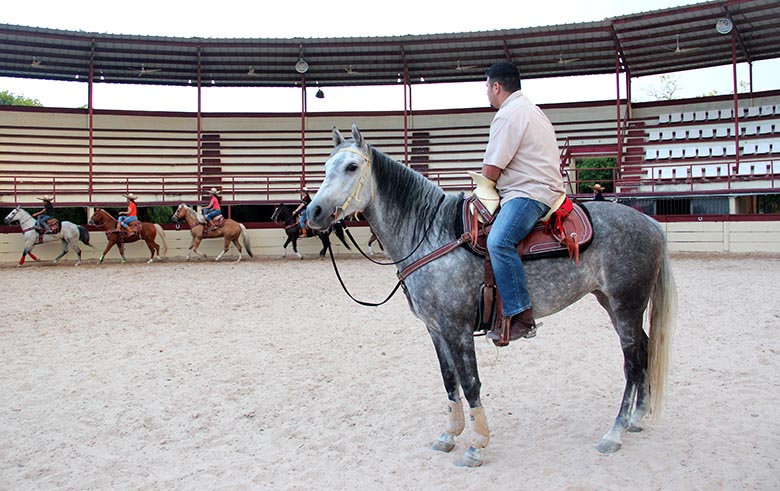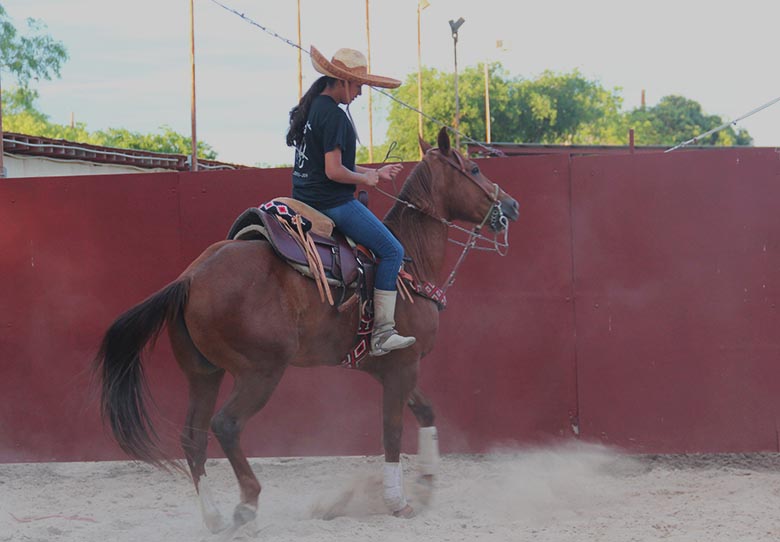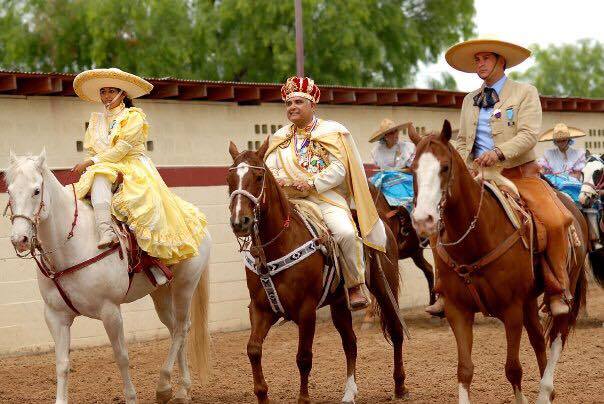On a recent evening, a group of horseback riders, ages 10-19, geared up for practice at El Rancho del Charro located on the South Side of San Antonio.
It was after school and the girls were wearing boots, spurs, jeans and casual T-shirts. The escaramuza (charro women) saddled the horses and adjusted according to their needs as some are taller than others. They proceeded to the arena and started with a warm up.
Jimmy Ayala, the director of the practicing group, made sure the girls were in the right positions and horses followed each other around the arena in the right formation. Riders’ voices echoed throughout the open air arena.

The girls rode the horses through the sand-filled arena and started spinning in circles. Sand scattered everywhere as the horses galloped through the enclosed perimeter. The charro women rode side saddle with a whip in their right hand. Half the horses were spinning. Some came to the center and crossed each other’s paths.
“Guera, don’t get to close to her, you’re touching the horse in front of her,” Ayala said to the 10 girls practicing.
Ayala started when his daughter, Jaquelyn, wanted to join Escaramuza at the age of 6. She is now 15 years old.
Ayala said the organization kept him close to his daughter when he was going through his divorce.
“I’ve been the behind-the-scenes dad doing everything such as bows, hair and sewing dresses,” Ayala said.

A former drumline instructor, he said it’s almost the same concept now being the charreada director.
“Everything is timing,” Ayala said.
Ayala’s grandfather was a charro back in the day and the one who got him started. He rode horses for a couple years then stopped when his daughters wanted to go full blast.
Ayala’s hard work as a director took escaramuza to nationals in California landing the girls second place in the state.
He says that he plays dad and director at the same time. He trains the girls and makes sure the horses are working and spinning correctly for the charreadas.
On this day, the girls train, perform and ride side saddle (sideways).
Ayala says there was a tradition where the girls who rode side saddle were called “adelitas” and there was an assumption that if girls straddled a horse’s back they would lose their virginity.
Ayala strongly believes that you can’t demand something if you can’t do it so he trains the girls riding side saddle himself, even though it’s only for girl competitors and performers.
El Rancho del Charro
The practicing grounds, El Rancho del Charro, is a ranch with nearly 26 members who, all together, own about 80 horses.
Member Mundo Rios says there is a $500 fee to become a voting member, and a $250 fee to establish non-voting rights.
Members pay a monthly fee of $100, which includes the right to have one horse and each additional horse costs $20.
Horses are assigned based on a rider’s particular expertise, though there’s many horses to choose from, and many of the animals are as historically important as Fiesta Charreada itself.
Paloma, who lived from 1984-2015, was known as a very special horse who participated every year along with the Kings. Paloma was purchased by Irma’s father for her when she was crowned in 2008.

The 31-year-old horse was used by several charro queens. As she continued to appear year after year, Paloma appeared in magazines, bus stops and even a few billboards.
“She sadly passed away in her sleep from an old age on the last day of Fiesta 2015,” Rodriguez said.
Paloma was mourned from past queens who knew her well.
Now there’s Patron. He is the current queen’s horse and is well known, as well as Muneco, a 13-year-old cinnamon gelding used for special guests and TV appearances.
The Charro organization’s mission is to educate the public on the history of charreria and experience rural life.
With Fiesta starting April 20, the Fiesta Charreadas open up their season to compete and exhibit from April-November.
Their goal is to show their way of life and a tradition that started nearly 400 years ago in the Haciendas of Mexico. The tradition only became a competitive sport 90 years ago.
Haciendas (estates) are large areas of land known for their significant mansions and large property.
Their task is to introduce attendees to a way of life lived for hundreds of years.
Fiesta Charreadas are their biggest event of the year and their primary fundraiser to maintain their grounds and livestock.
“It is also our ‘rebirth’ for the year,” said Irma Iris Duran de Rodriguez. Rodriguez is the PMO Fiesta Commissioner, Asociación de Charros in San Antonio.
Duran de Rodríguez said teams practice for two months every Monday, Wednesday and Friday night to prepare for the event.
The organization is a non-profit and 100 percent volunteer based.
The Asociacion will host A Day in Old Mexico & Charreada, an official Fiesta San Antonio event at Rancho Del Charro on April 23.
The event gives people the opportunity to show their deeply rooted culture and traditions.
There will be food, drinks, pony rides, Ballet Folklorico performances and live Mariachi music in this family event.
The famous Rey Feo LXIX will be honored at the event. He and King Antonio XCV participates every year as each Fiesta Charreada is dedicated to a king.
They both spend time with their team members practicing their time to lead the parade during their opening ceremonies.





